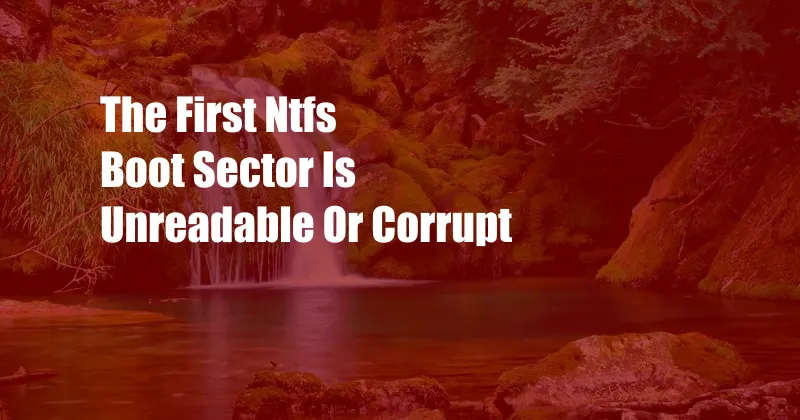
Unreadable or Corrupt First NTFS Boot Sector: A Comprehensive Guide
As I tirelessly pursued a complex software installation, a cryptic error message abruptly halted my progress: “The first NTFS boot sector is unreadable or corrupt.” This enigmatic message left me baffled and frustrated, prompting me to delve into the enigmatic world of boot sectors and NTFS file systems.
Understanding NTFS Boot Sectors
NTFS (New Technology File System) is a robust file system commonly employed in modern operating systems. The boot sector, a crucial part of any partitioned storage device, plays a pivotal role in initializing the operating system. When a computer boots up, the BIOS (Basic Input/Output System) identifies the boot sector and loads the operating system files from it.
Causes of Corruption
Corruption of the first NTFS boot sector can arise from a myriad of scenarios:
- Power Surges and Outages: Unexpected interruptions in power supply can cause data corruption within the boot sector.
- Malware Infections: Malicious software can deliberately target and damage the boot sector, rendering it unreadable.
- Hardware Malfunctions: Faulty or failing storage devices can lead to data inconsistencies, including boot sector corruption.
- Incorrect Drive Partitioning: Improper handling of drive partitioning can result in accidental damage to the boot sector.
Symptoms of Corruption
An unreadable or corrupt first NTFS boot sector manifests itself through several telltale signs:
- Boot Failure: The computer fails to boot or hangs indefinitely during the boot process.
- Error Messages: Cryptic error messages, such as “The first NTFS boot sector is unreadable or corrupt,” are displayed on the screen.
- Data Loss: The affected drive may become inaccessible, leading to potential data loss.
Troubleshooting and Repair
Addressing a corrupt first NTFS boot sector requires a two-pronged approach: identifying the cause and implementing an effective repair strategy.
- Identify the Cause: Determine the underlying reason for the corruption. Run hardware diagnostics to rule out hardware issues. Scan for malware infections using reliable antivirus software.
- Repair Strategies:
- CHKDSK: Windows includes a built-in utility called CHKDSK (Check Disk) that can scan and repair disk errors. Run “chkdsk /f /r” on the affected drive to locate and fix boot sector issues.
- Boot Repair Tools: Dedicated boot repair tools, such as “Windows Boot Genius” or “Boot Repair Disk,” can automatically diagnose and fix boot sector problems.
- Reinstall Operating System: In severe cases, reinstalling the operating system from a bootable USB or DVD may be necessary to replace the corrupted boot sector.
Expert Tips and Advice
Based on my experience, I offer the following tips to minimize the risk of boot sector corruption:
- Regular Backups: Create regular backups of important data to safeguard against data loss due to boot sector failures.
- Surge Protection: Use a surge protector to prevent power surges from damaging storage devices.
- Malware Protection: Maintain up-to-date antivirus software to protect against malware infections that can target boot sectors.
- Proper Drive Handling: Handle storage devices with care and avoid mishandling or accidental partitioning errors.
Frequently Asked Questions
Q: Can I recover data from a drive with a corrupt first NTFS boot sector?
A: Yes, using data recovery software or specialized tools, it may be possible to extract data from a drive with a corrupted boot sector.
Q: Why does my computer keep crashing after repairing the boot sector?
A: Additional hardware issues or software conflicts may be causing the crashes. Consider running hardware diagnostics and reviewing recent software installations.
Q: Can I upgrade my BIOS to resolve boot sector issues?
A: In some cases, a BIOS update may address compatibility issues that can lead to boot sector problems. However, consult your motherboard manufacturer’s documentation before updating the BIOS.
Conclusion
Navigating the enigmatic realm of boot sectors and NTFS file systems can be daunting, but understanding the causes, symptoms, and repair strategies for a corrupt first NTFS boot sector empowers you to effectively troubleshoot and resolve this issue. By implementing the aforementioned tips and seeking expert advice, you can safeguard your data, ensure a smooth boot process, and maintain the integrity of your storage devices.
Are you interested in further exploring the fascinating world of boot sectors and file systems? Share your thoughts and questions in the comments below!